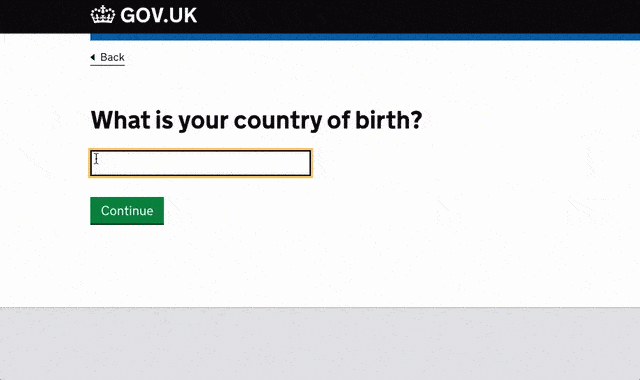govuk-country-and-territory-autocomplete v2.0.0
GOV.UK country and territory autocomplete - what it is and how to use it
The country and territory autocomplete is a component that helps users choose countries and territories in answers. You should only use this component for services where users have to provide their country or territory.
This component includes complete functionality to make it faster and easier for users to find a location. For example, to select their country of birth or their current location.
For other types of question, you should use the accessible autocomplete. To find information about this component, go to the accessible-autocomplete README.
The autocomplete uses data from the UK government's country and territory registers. To configure the data used in the autocomplete to suit the specific needs of your product or service, please raise an issue.
The autocomplete itself follows the common look and feel of GOV.UK in line with the design principles, and should work with recommended browsers and assistive technologies.

This guide will show you how to:
- populate the autocomplete field
- use the autocomplete's data file
Support
The GOV.UK Design System team maintains the country and territory autocomplete. However, we’re only able to put in minimal work to support it.
Read about our plans to maintain this component.
Read more about the types of support we can provide.
Integration process
To integrate an application with the autocomplete, you'll need to:
- use the data from the country and territory registers
- create an accessible autocomplete widget
- keep the data up to date
Add location data from country and territory registers
To use register data in the autocomplete, you will need two files:
- location-autocomplete-canonical-list.json - a list of every canonical country and territory
- location-autocomplete-graph.json - a directed acyclic graph mapping canonical locations to abbreviations, synonyms, endonyms, and typos
The location-autocomplete-graph.json file only contains examples of synonyms, abbreviations, endonyms and typos you might want to consider. It is not a comprehensive list. You may wish to add or remove items based on your own user research.
Copy both files to your application. The location-autocomplete-graph.json file must be exposed as a public asset.
You can also install the location autocomplete using npm:
$ npm install govuk-country-and-territory-autocomplete
$ ls node_modules/govuk-country-and-territory-autocomplete/dist/
location-autocomplete-canonical-list.json
location-autocomplete-graph.json
location-autocomplete.min.css
location-autocomplete.min.js
location-autocomplete.min.js.mapThe location-autocomplete-canonical-list.json file contains an array of arrays containing the location names and ISO codes:
> JSON.parse(fs.readFileSync('data/location-autocomplete-canonical-list.json', 'utf8'))
[["Abu Dhabi", "territory:AE-AZ"], ["Afghanistan", "country:AF"], …]You should parse this file on your application's server or as part of the build process to produce a plain HTML <select> dropdown. This is your progressive enhancement fallback. You should render something that looks like this:
<select id="location-autocomplete">
<option value="territory:AE-AZ">Abu Dhabi</option>
<option value="country:AF">Afghanistan</option>
…
</select>Create an accessible autocomplete widget
To make it easier for users to find a location using the autocomplete, you should progressively enhance the front-end to add auto-complete functionality. As a user types, the autocomplete will suggest a list of possible locations for the user to choose from.
On the page where you're rendering the previous <select> dropdown, include the following HTML, updating the /assets/ URLs as needed for your application:
<!-- In your <head> -->
<link rel="stylesheet" href="/assets/location-autocomplete.min.css" />
<!-- At the end of your <body> -->
<script type="text/javascript" src="/assets/location-autocomplete.min.js"></script>
<script type="text/javascript">
openregisterLocationPicker({
selectElement: document.getElementById('location-autocomplete'),
url: '/assets/location-autocomplete-graph.json'
})
</script>This will render the same <select> menu as before on the server, but hides it and progressively enhances to a autocomplete when JavaScript kicks in. When the user selects something in the autocomplete, the hidden <select> menu is still updated, so everything works as before.
If you prefer to learn by reading the source, try out the example.
Adding additional entries and synonyms
You can pass in custom entries and synonyms using the additionalEntries and additionalSynonyms option:
<script type="text/javascript">
openregisterLocationPicker({
additionalEntries: [
{ name: 'Atlantis', code: 'country:AN' }
],
additionalSynonyms: [
{ name: 'Albion', code: 'country:GB' }
],
selectElement: document.getElementById('location-autocomplete'),
url: '/assets/location-autocomplete-graph.json'
})
</script>You can additionally specify custom synonyms on the <option> elements by using the data-additional-synonyms attribute:
<select id="location-autocomplete">
<option value="territory:GB" data-additional-synonyms='["Blighty"]'>United Kingdom</option>
<option value="country:RO" data-additional-synonyms='["Dacia"]'>Romania</option>
</select>Keep the data up to date
Government Digital Service will publish new versions of the govuk-country-and-territory-autocomplete package when the data changes, such as when countries are renamed.
To keep up to date, you can use dependency monitoring tools, such as:
- Greenkeeper, a GitHub bot that will submit pull requests to your open source project when there are new versions of your dependencies
- David, a command line tool that can be configured to run on your continuous integration environment and return a non-zero status when there are new versions of your dependencies
Glossary
country register - A list of British English-language names and descriptive terms for countries.
location - A country or territory.
autocomplete - A widget that allows you to choose from items in a register.
register - A list of information designed to be an accurate and up-to-date source of data from government. Once entered into a register, the contents can only be added to, they cannot be deleted or rewritten.
territory - An administrative or geographical entity that isn't recognised as a country by the UK.
territory register - A list of British English-language names and descriptive terms for political, administrative and geographical entities that aren’t recognised as countries by the UK.
Releasing
- Update CHANGELOG
- Update package.json
npm version- Merge to
main - Create GitHub release tag
npm publish